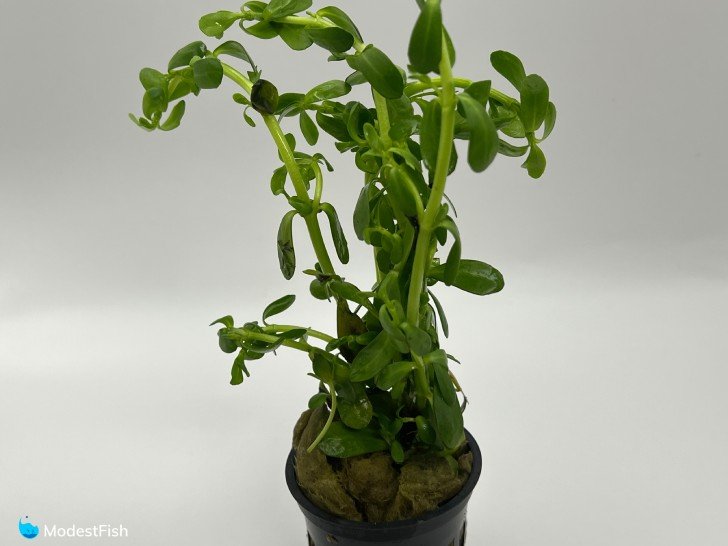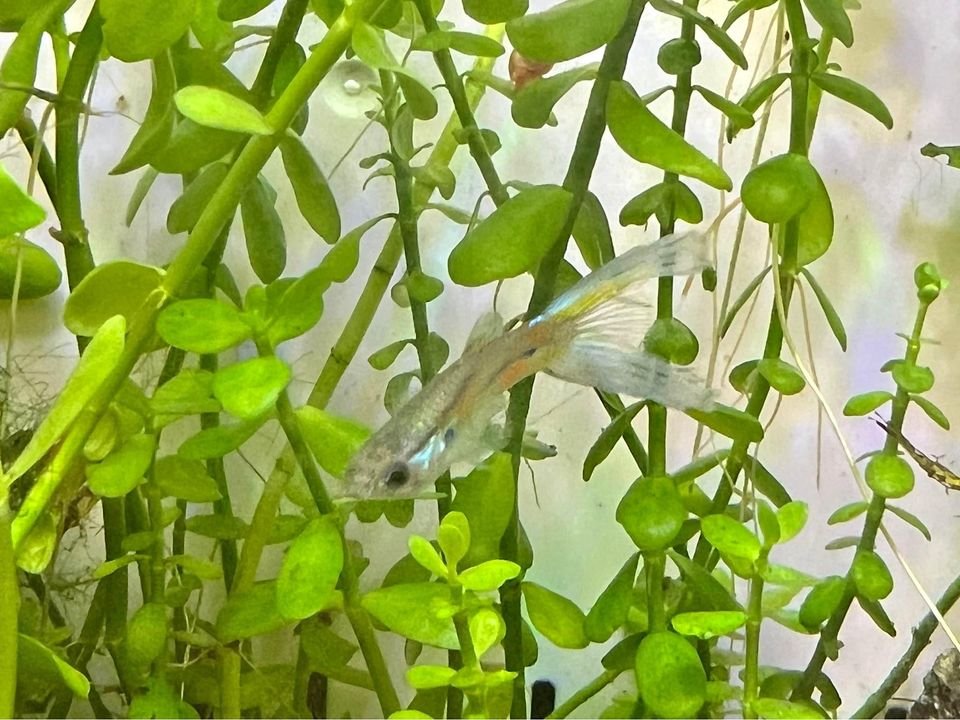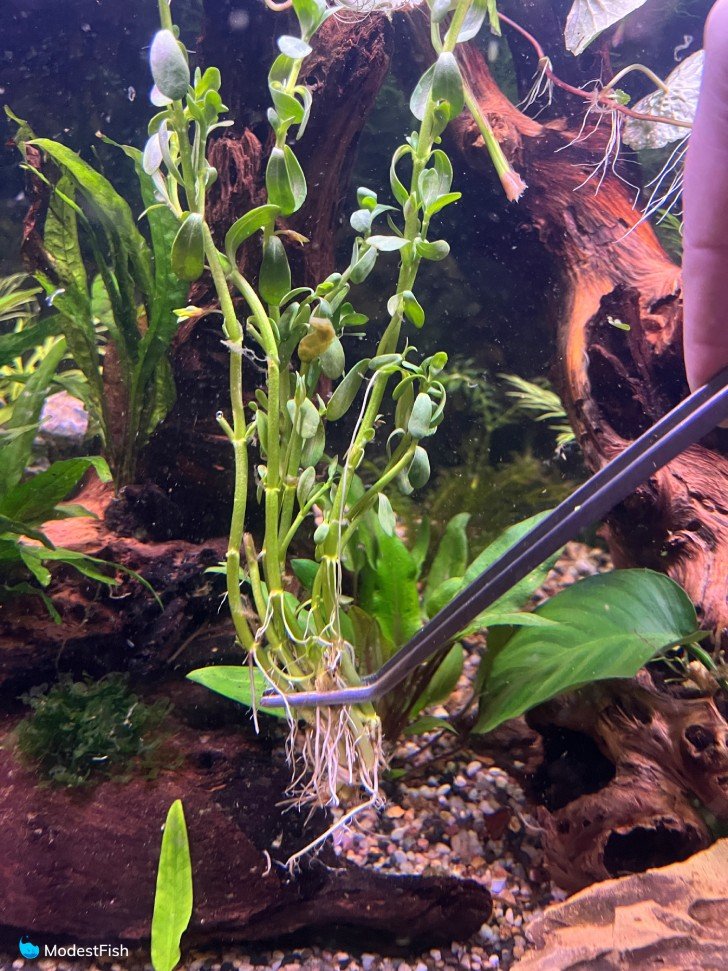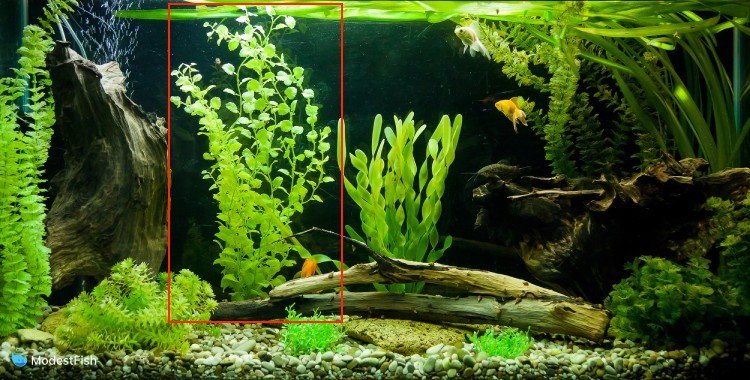Moneywort (Bacopa monnieri), also known as bacopa or waterhyssop, is an easy to grow stem plant.
It can reach heights of up to 12 inches and makes an excellent background plant for medium to large tanks.
In this guide, I’ll teach you how to provide the right care for moneywort plant, including how to plant, propagate, and which tanks it suits best.
Moneywort Quick Care Stats
- Scientific Name: Bacopa monnieri
- Family: Plantaginaceae
- Order: Lamiales
- Genus: Bacopa
- Care Level: easy
- Growth Rate: medium
- Maximum Size: 12 inches (30 centimeters)
- Water Conditions: pH range of 6.0-8.0, temperature 68°-80°F (20°-27°C)
- Lighting: low to medium
- Propagation: cuttings
- Tank Placement: background
Table of Contents
Overview of Moneywort (Bacopa monnieri)

Moneywort (Bacopa monnieri), also known as bacopa or waterhyssop, is an easy to grow stem plant.
It can reach heights of up to 12 inches and makes an excellent background plant for medium to large tanks.
Growing long skinny stems that reach towards the surface of the water. Small, bright green leaves with rounded edges grow in pairs along the entire length of the stems.
Moneywort can tolerate a wide variety of conditions; I’ve personally grown this plant in both unheated and tropical tanks. Although, I have found that it grows faster in heated tanks.
Overall, I think this plant is easy to take care of, thriving on benign neglect.
I especially like to use this plant in aquariums with small, shy fish. It provides them with lots of cover for when they want to retreat.
It’s also a great addition to a shrimp tank. Shrimp will graze on algae growing on the stems and leaves of this tall plant.
There’s no need for an elaborate setup to grow moneywort. Of course, CO2 and heavy fertilizers will make it grow faster, but they are by no means a requirement. Moneywort will do just fine in a low tech setup.
This is a great plant for beginners.
Caring for Moneywort In Aquarium

Tank Requirements
Moneywort can grow quite tall fairly quickly, depending on the environment. I’d recommend it for tanks 20 gallons (76 liters) or larger.
You could keep it in something like a 10 gallon (39 liter), but you would need to trim it frequently, which can be a bit annoying.
Water Parameters
- Temperature: 68°-80°F (20°-27°C)
- pH: 6.0-8.0
- dGH: 3-15
Lighting Conditions
Moneywort isn’t picky when it comes to light levels. I’ve always grown it under both low and medium lighting.
It can be a little leggier under low light, but it will usually become more robust as it gets closer to the water’s surface.
Substrate & Fertilizers
Moneywort is a stem plant, meaning that it derives its nutrients directly from the water column. It does put out roots, but these are meant to anchor the plant, not provide it with food.
Because of this, it doesn’t really matter what kind of substrate you use.
This species only requires light fertilization. I’ve had great success by simply adding some Seachem Flourish every week to two weeks to add some macro nutrients to the water column.
Trimming & Maintenance
The only maintenance this plant really needs is occasional trimming. I like to let mine get really tall. It grows along the top of the water and puts out these really cute little white flowers that I enjoy.
But, if you do want to keep it trimmed, you can replant the cuttings in the substrate and new plants will grow from them.
I use long-handled aquarium plant scissors to trim my moneywort, nothing to it.
I’ve been using this little kit to do all my plant maintenance for several years now.

Last update on 2024-04-21 / Commissions Earned / Images from Amazon Product Advertising API
How to Plant Moneywort
Planting moneywort is very simple.
It usually comes in bunches weighed down by lead ties. Remove the ties and bury about 2 inches (5 centimeters) of the stem down in the substrate.

If the plants want to float and pull themselves back out, you can weigh them down by placing some rocks or decor at the base of each one.
After a week or so, the stems will put out roots and anchor the plants.
How to Propagate Moneywort
You propagate this plant by cutting. Simply cut off the top 6 inches (15 centimeters) of the stem and bury the cut end down in the substrate. Super easy.
Tank Mates for Moneywort
Small fish and ornamental shrimp are excellent tank mates for moneywort. They’ll use this plant as a feeding ground and hiding spot.
You can keep most fish with moneywort. I’ve planted it in tanks with angels, rainbowfish, livebearers, barbs, etc. There’s never been a problem.
But, avoid fish that like to dig up or eat plants:
- Goldfish
- Large cichlids
- Large plecos
Your beautiful moneywort will just be a tasty snack for fish like these.
How to Use Moneywort in Aquarium

I would generally advise using moneywort as a background plant in most tanks.
If you have a particularly large tank, 100 gallons (379 liters) or more, then you could use this plant in the midground.
You can also plant it in dense patches if you want to provide cover for fry. Baby fish can hide among the stems and feed on the infusoria that will grow around it.
Is Moneywort Right for You?
Moneywort is an excellent choice for both experienced and novice fishkeepers.
It’s not hard to grow or maintain, it’s very attractive and will even flower if it’s allowed to breach the water’s surface.
You don’t need a fancy setup. I’ve had great success with it in several different low tech tanks. Just a little liquid fertilizer every now and then is more than sufficient to grow a beautiful specimen.
I would recommend this plant to just about any aquarist.
I hope you find this article helpful.
I wish you and your fish the very best!
